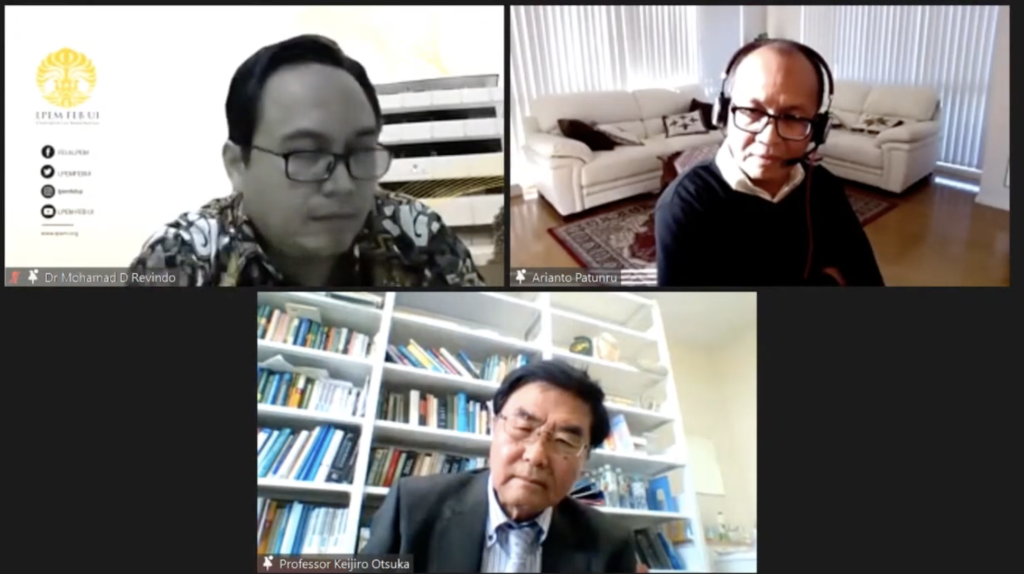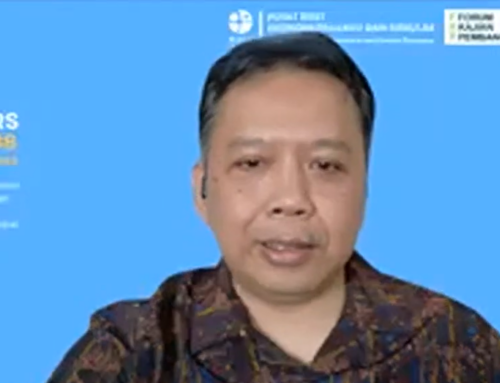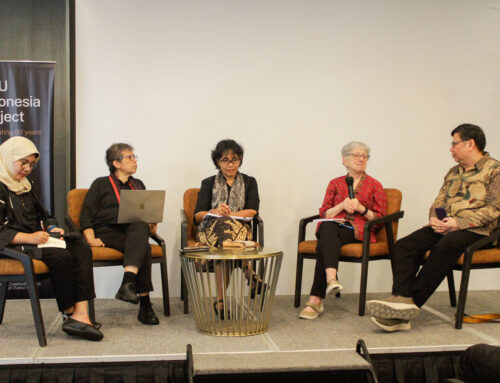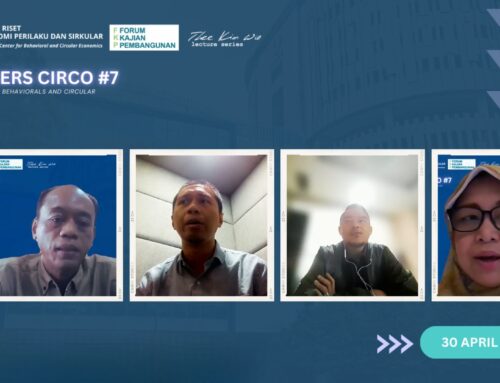Speakers: HE Dr Sri Mulyani Indrawati (Indonesian Minister of Finance), Professor Keijiro Otsuka (Kobe University and Institute of Developing Economies, Tokyo), and Dr M. Dian Revindo (LPEM FEB UI). Thursday, 29 April 2021.
Update: the paper on which this Lecture is based on, has been published as: (2021) “Strategy for Transforming Indonesian Agriculture”, Bulletin of Indonesian Economic Studies, 57:3, 321-341, DOI: 10.1080/00074918.2021.2002387
SUMMARY
- Since 2007, LPEM FEB UI and the ANU Indonesia Project have jointly organized the annual Sadli Lecture series to broaden understanding and stimulate debate among students, academics and policy makers of the key economic policy challenges faced by Indonesia, drawing on the experience of neighbouring countries. It is named in honour of the late Professor Mohammad Sadli who was one of Indonesia’s most influential commentators on economic affairs during his lifetime. The annual Lecture is based on a commissioned paper on Indonesia in comparative economic perspective, published each year in the August edition of the Bulletin of Indonesian Economic Studies. This year’s Sadli Lecture is the 15th in the series and discussed strategies for strengthening Indonesian agriculture, based on a paper by Keijiro Otsuka (Professor of Development Economics, Kobe University and Chief Senior Researcher at the Institute of Developing Economies, Tokyo).
- Agriculture is a key sector of Indonesia’s national economy. However, the sector’s contribution to the national economy has been declining. In her keynote remarks, Sri Mulyani (Minister of Finance) pointed out that Indonesia’s government has allocated almost 100trillion rupiah for food security in 2021. The budget is used to increase the productivity of food commodities such as fertilizer subsidy, infrastructure, and utilization of technology. However, the support has largely been ineffective in increasing agricultural productivity. Fertilizer subsidy has been increasing constantly, but rice productivity does not match the movement of fertilizer subsidy. Under these conditions, Indonesia needs major reforms to increase the growth of the agricultural sector and overcome many problems of inefficiency.
- Traditionally, the major role of agriculture is to achieve food security by increasing food production, particularly rice in the context of Asia. In the Green Revolution (global agricultural modernization in the 1960s), Indonesia’s performance in agriculture was outstanding, transforming Indonesia from a major rice importer to a self-sufficient country. However, agricultural problems change over time with the development of the economy, partly due to the changes in the structure of the demand for agricultural products and also due to the increase in labor costs.
- Keijiro Otsuka (Professor at Kobe University, Japan) argues that Indonesia is currently losing its comparative advantage in rice production. Indonesia is self-sufficient in rice production but at the cost of high domestic rice prices. On the other hand, the production of high-value agricultural products (HVPs) as other sources of agricultural development, is far from adequate, despite the increasing demand for them. Also, rural industrialization to increase productivity is still limited. What are some of the ways in which Indonesian agriculture can be strengthened?
- First, farm size in Indonesia is too tiny. Even worse, the average farm size has been declining over time. To maintain a comparative advantage in rice farming in Indonesia, Otsuka argued that farm size must be expanded significantly and large-scale mechanization must be introduced. Rice self-sufficiency has already been achieved, but this is due to rice price support by import control. However, self-sufficiency of rice by price support cannot be a sustainable solution, it will preserve inefficient small farms which will increase the cost of rice production and eventually require more amount of price support. The Japanese rice price support program is an excellent example of a bad agricultural policy. Unfortunately, Taiwan and South Koreas followed the Japanese path.
- Since there are symptoms that large farms are more productive than small farms in Indonesia, farm size expansion must be promoted. Since rice farms are too small in Java, Otsuka argued that rice production should be shifted to outer islands, with conditions that the farm size expansion must be followed by facilitating land rental transactions, consolidating small parcels, and supporting mechanization. In this case, the expansion must be carried out by the government. Establishing large “rice plantations” managed by private companies is a bad policy because they are bound to be inefficient due to the high monitoring cost of hired workers. There are other problems for relocating rice production outside Java, i.e. efficiency issues (rice has been cultivated in Java for hundreds of years whereas outside Java it is relatively more recently introduced) and environmental and social impacts as we’ve seen in the transmigration program in the past.
- HVPs as other sources of agricultural development are another important area of Indonesian agriculture that can be strengthened. Demand for HVPs has been increasing for better nutrition and health. Yet, the supply of HVPs fails to keep pace with their growing demand in developing countries, including Indonesia. In Indonesia, areas for growing fruits and vegetables account for a tiny fraction of the cultivation area. Furthermore, the import of fruit and vegetables has been increasing substantially, reflecting insufficient domestic supply.
- It is not easy to promote the production of HVPs, production of HVPs may be risky because of large price fluctuations. Since HVPs are new, farmers may not know how to produce them and extension systems may not be working. Also, the markets of new seeds and safe pesticides may be absent or underdeveloped. The credit market is also unlikely to be working to assist the purchase of new inputs.
- Because of the difficulty in initiating HVPs, contract farming is rising. Since contract farming introduces new crops and new improved production methods, it will certainly contribute to the modernization of agriculture in developing countries. However, farmers would not receive large benefits from production contracts, because farmers passively accept inputs and production instructions without undertaking any major management and marketing decisions. This means that farmers do not receive entrepreneurial profits. It also seems that farmers are not significantly made better-off by marketing contracts, because of the inadequate provision of production knowledge and new inputs.
- HVPs are therefore preferable to contract farming. To promote HVPs and make farmers significantly better-off, Indonesia must transform “subsistence” farmers into entrepreneurs, who are capable of making appropriate management and marketing decisions, by offering intensive management training and by strengthening extension systems. Also, Indonesia needs to train agro-processors, because it is by now widely recognized among development economists that a major missing factor for the development of manufacturing enterprises is managerial human capital. The development of the agro-processing industry ought to be the core of rural industrialization, which provides not only employment opportunities in rural areas but also stimulates the production of HVPs. Pack-houses, which are engaged in washing, fumigating, grading, and packaging fresh fruit and vegetables by employing a large number of workers, is an important part of the agro-processing industry.
- The third issue raised in regarding environmental sustainability and agricultural productivity and Otsuka used oil palm production in Indonesia as an example. Oil palm plantations have several advantages, namely scale economies in processing, efficient coordination in its operation, and better access to finance. However, the problem is again the high monitoring cost of hired workers. Smallholders are argued to be more efficient than plantations, and now they are dominating plantations in the production of perennial crops in the developing world. The Indonesian government obliges plantations to offer contract farming to smallholders. Yet, independent smallholders have been increasing. Some researchers found that 75% of sample smallholders are independent, starting from only 5% in the early 1990s. However, the yield of independent smallholders is much lower than that of contracted smallholders, because independent smallholders apply less fertilizer, their harvesting cycle is too long, and the mortality of their plants is high.
- However, the fact that most smallholders prefer independent farming strongly indicates that independent farming is more profitable than contract farming. Moreover, the advantage of contract farming is likely to be small in the case of oil palm production, because of the absence of quality uncertainty, the use of fallen fruit for seeds, learning from contract farmers, and good access to palm oil mills.
- Given that extensification or increasing production by expanding cultivation areas by clearing forests is no longer viable and acceptable options, intensification of oil palm production must be the key strategy to promote oil palm production. It is important to intensify oil palm production without deforestation and social conflict. Three fundamental requirements for intensification are: strengthening extension for independent smallholders, train managers and owners of palm oil mills, particularly about management, and establishing secure land rights for smallholders, which provides proper incentives to invest in sustainable management of natural resources.
- There are some important notes for the presentation by Prof. Otsuka. In the presentation, professor Otsuka highlighted the importance of land titling. Land titling is very important to give farmers security, but at the same time, it is also risky. This is because once the land is titled, the market price of the land is very high, and the farmers will be tempted to sell the land. Therefore, financial literacy following land titling is crucial. As an alternative, rather than individual land titles, titles can be given to a community but this will require changes and strengthening of Indonesian land laws.
- Another point to note is Prof Otsuka’s critics of price support of rice. There is an imperfect market of other agricultural inputs, such as fertilizer, improved seeds, and safe pesticides. Therefore it is difficult to abolish price support without reducing production cost. Even with the price support, the price is still considered too low for the farmers.
- One of the main messages of Prof Otsuka is that land transactions are superior to labor transactions. However, the problem with land transactions is institutional. It is a problem of insecure property rights and land which impedes the movement of land from inefficient small farms to larger farms where the land will be more productive. It is an institutional problem that can be fixed by the policy. Unfortunately, the policy cannot do anything about the problem of labor markets, monitoring of labor inputs is going to be a problem regardless of any policy.





